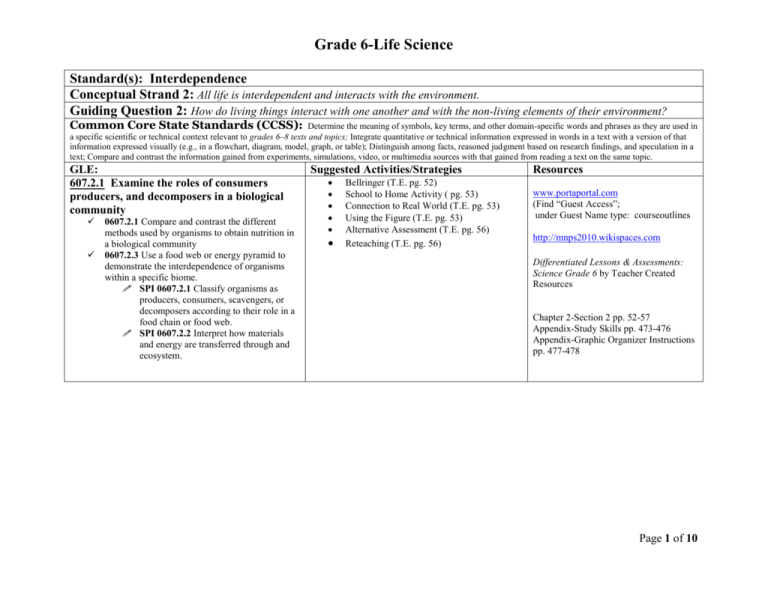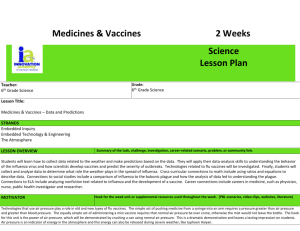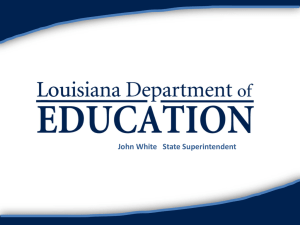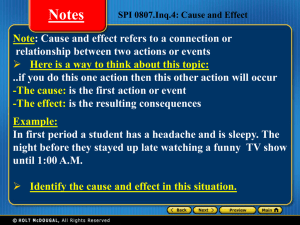Guiding Question 2 - MNPS2010
advertisement

Grade 6-Life Science Standard(s): Interdependence Conceptual Strand 2: All life is interdependent and interacts with the environment. Guiding Question 2: How do living things interact with one another and with the non-living elements of their environment? Common Core State Standards (CCSS): Determine the meaning of symbols, key terms, and other domain-specific words and phrases as they are used in a specific scientific or technical context relevant to grades 6–8 texts and topics; Integrate quantitative or technical information expressed in words in a text with a version of that information expressed visually (e.g., in a flowchart, diagram, model, graph, or table); Distinguish among facts, reasoned judgment based on research findings, and speculation in a text; Compare and contrast the information gained from experiments, simulations, video, or multimedia sources with that gained from reading a text on the same topic. GLE: 607.2.1 Examine the roles of consumers producers, and decomposers in a biological community 0607.2.1 Compare and contrast the different methods used by organisms to obtain nutrition in a biological community 0607.2.3 Use a food web or energy pyramid to demonstrate the interdependence of organisms within a specific biome. SPI 0607.2.1 Classify organisms as producers, consumers, scavengers, or decomposers according to their role in a food chain or food web. SPI 0607.2.2 Interpret how materials and energy are transferred through and ecosystem. Suggested Activities/Strategies Bellringer (T.E. pg. 52) School to Home Activity ( pg. 53) Connection to Real World (T.E. pg. 53) Using the Figure (T.E. pg. 53) Alternative Assessment (T.E. pg. 56) Reteaching (T.E. pg. 56) Resources www.portaportal.com (Find “Guest Access”; under Guest Name type: courseoutlines http://mnps2010.wikispaces.com Differentiated Lessons & Assessments: Science Grade 6 by Teacher Created Resources Chapter 2-Section 2 pp. 52-57 Appendix-Study Skills pp. 473-476 Appendix-Graphic Organizer Instructions pp. 477-478 Page 1 of 10 Grade 6-Life Science 607.2.2 Describe how matter and energy are transferred through an ecosystem 0607.2.1 Compare and contrast the different methods used by organisms to obtain nutrition in a biological community 0607.2.3 Use a food web or energy pyramid to demonstrate the interdependence of organisms within a specific biome. SPI 0607.2.1 Classify organisms as producers, consumers, scavengers, or decomposers according to their role in a food chain or food web. SPI 0607.2.2 Interpret how materials and energy are transferred through and ecosystem. GLE: Activities/Strategies 607.2.3 Draw conclusions from data about interactions between the biotic and abiotic elements of a particular environment o Chapter 2-Section 2 English Language Learners (T.E. pg. 53) Using the Figure (T.E. pg. 53) Reteaching (T.E. pg. 56) Alternative Assessment (T.E. pg. 56) o Chapter 3-Section 1 Bellringer (T.E. pg.76) Connection To Technology (pg. 77) Inclusion Strategies (T.E. pg. 77) Reteaching (T.E. pg. 78) Alternative Assessment (T.E. pg. 78) Connection To Environmental Science (pg. 79) Skills Practice Lab (Nitrogen Need) pp. 8485 Model-Making Lab (A Passel o’ Pioneers) pp. 452-453 Connection t Biology pg. 356 0607.2.2 Create a graphic organize that illustrates how biotic and abiotic elements of an environment interact SPI 0607.2.2 Interpret how materials and energy are transferred through and ecosystem. o Chapter 2-Section 1 Bellringer (T.E. pg. 48) Group Activity (T.E. pg. 48) Quick Lab (pg. 49) Inclusion Strategy (T.E. pg. 49) Connection To Engineering (T.E. pg. 50) Reteaching (T.E. pg. 50) Alternative Assessment (T.E. pg. 56) o Chapter 4-Section 2 Bellringer (T.E. pg. 102) Group Activity (T.E. pg. 105) o Chapter 4-Section 3 Bellringer (T.E. pg. 108) Alternative Assessments (T.E. pg. 368) Chapter 2-Section 2 pp. 52-57 Chapter 3-Section 1 pp. 76-79 Chapter 4-Section 2 pp. 102-107 Appendix-Study Skills pp. 473-476 Appendix-Graphic Organizer Instructions pp. 477-478 Resources Chapter 2- Section 1 pp. 48-51 Chapter 4-Section 2 pp. 102-107 Chapter 4-Section 3 pp. 108-111 Page 2 of 10 Grade 6-Life Science 607.2.4 Analyze the environment and the interdependence among organisms found in the world’s major biomes 0607.2.2 Create poster presentations to illustrate differences among the world’s major biomes. 0607.2.3 Use a food web or energy pyramid to demonstrate the interdependence of organisms within a specific biome. SPI 0607.2.2 Interpret how materials and energy are transferred through an ecosystem SPI 0607.2.3 Identify the biotic and abiotic elements of the major biomes. SPI 0607.2.4 Identify the environmental conditions and interdependencies among organisms found in the major biomes o Chapter 2-Section 3 Bellringer (T.E. pg. 58) Inclusion Strategies (T.E. pg. 59) Teach Activity (T.E. pg. 60) English Language Learners (T.E. pg, 60) Connection Activity (T.E. pg. 62) Activity (T.E. pg. 63) Reteaching (T.E. pg. 64) Alternative Assessment (T.E. pg. 64) o Chapter 3-Section 2 Bellringer (T.E. pg. 80) English Language Learners (T.E. pg. 81) Reteaching (T.E. pg 82) Alternative Assessment (T.E. pg. 82) Homework (T.E. pg. 82) o Chapter 4- Section 1 Bellringer (T.E. pg. 94) English Language Learners (T.E. pg. 95) Group Activity (T.E. pg. 96) Connection Activity (T.E. pg. 97) Cultural Awareness (T.E. pg. 98) Inclusion Stratgies (T.E. pg. 99) Reteaching (T.E. pg. 100) Alternative Assessment (T.E. pg. 100) School to Home (pg. 100) o Chapter 4-Section 2 Motivate Discussion (T.E. pg. 102) Connection To Engineering (pg. 105) Reteaching (T.E. pg. 106) Alternative Assessment (T.E. 106) o Chapter 4-Section 3 Quick lab (pg. 109) Reteaching (T.E. pg. 110) Inclusion Strategies (T.E. pg. 110) Inquiry Lab (Discovering Mini-Ecosystems) pp. 454 Inquiry Lab (Life in the Desert) pp. 455 CCSS –School to Home (S.E pg. 100) CCSS –Quick Lab (S.E pg. 109) Chapter 2- Section 3 pp. 58-65 Chapter 3-Section 2 pp. 80-83 Chapter 4- Section 1 pp. 94-101 Chapter 4-Section 2 pp. 102-107 Chapter 4-Section 3 pp. 108-111 Appendix-Study Skills pp. 473-476 Appendix-Graphic Organizer Instructions pp. 477-478 Page 3 of 10 Grade 6-Life Science Suggested Integrated Activities Reading\Language Arts o Using the Figures-Reading\Language Arts(T.E. pg. 53) o Research Peregrine Falcons-Reading\Language Arts(T.E. pg. 55) o Alternative Assessment-Reading\Language Arts(T.E. pg. 56) o Science in Action- Math\Reading\Language\Social Studies(pg. 72-73) o Connection Activity-Reading\Language Arts (T.E. pg. 104) o Rigs for Reefs-Reading\Language Arts (T.E. pg. 105) o English Language Learners- Reading\Language Arts (T.E. pg. 109) o Alternative Assessment-Reading\Language Arts (T.E. pg. 110) o Connection to Language-Reading\Language Arts (T.E. pg. 110) o Science in Action- Math\Reading\Language\Social Studies(pg. 118-119) Math-Appendix-Useful Equations pp. 481\Math Refresher pp. 483-489 o Math Practice-(T.E. pg. 57) o Connection to Math- (T.E. pg. 54) o Connection to Math- (T.E. pg. 61) o Science in Action- Math\Reading\Language\Social Studies(pg. 72-73) o Math Practice – (pg. 77)Connection Activity-Math (T.E. pg. 81) o Science in Action- Reading\Language\Social Studies(pg. 90-91) o Connection Activity-Math (T.E. pg. 96) o English Language Learners-Math (T.E. pg. 103) o Activity-Math (T.E. pg. 109) o Science in Action- Math\Reading\Language\Social Studies(pg. 118-119) Social Studies o Connection to Social Studies –(pg. 64) o Science in Action- Math\Reading\Language\Social Studies(pg. 72-73) o Science in Action- Reading\Language\Social Studies(pg. 90-91) o Cultural Awareness- Social Studies (T.E. pg. 98) o Cultural Awareness-Social Studies (T.E. p. 103) o Science in Action- Math\Reading\Language\Social Studies(pg. 118-119) Page 4 of 10 Grade 6-Life Science Standard(s): Grade 6 : Embedded Technology & Engineering Conceptual Strand: Society benefits when engineers apply scientific discoveries to design materials and processes that develop into enabling technologies. Guiding Question: How do science concepts, engineering skills, and applications of technology improve the quality of life? GLE: 0607.T/E.1 Explore how technology responds to social, political, and economic needs. Resources Connection To Engineering pg. 50 Connection To Technology pg. 77 Connection To Engineering pg. 105 Chapter 1 pp. 4-43 Appendix -Engineering Design Process pp. 492-493 Connection To Engineering pg. 99 Appendix -Engineering Design Process pp. 492-493 0607.T/E.1 Use appropriate tools to test for strength, hardness, and flexibility of materials. SPI 0607.T/E.1 Identify the tools and procedures needed to test the design features of a prototype. 0607.T/E.2 Know that the engineering design process involves an ongoing series of events that incorporate design constraints, model building, testing, evaluating, modifying, and retesting. Activities/Strategies 0607.T/E.2 Apply the engineering design process to construct a prototype that meets certain specifications. SPI 0607.T/E.2 Evaluate a protocol to determine if the engineering design process was successfully applied. Page 5 of 10 Grade 6-Life Science 0607.T/E.3 Compare the intended benefits with the unintended consequences of a new technology. Connection to Engineering pg. 23 Connection to Engineering pg. 27 Chapter 1 pp. 4-43 0607.T/E.3 Explore how the unintended consequences of new technologies can impact society. 0607.T/E.4 Research bioengineering technologies that advance health and contribute to improvements in our daily lives. SPI 0607.T/E.3 Distinguish between the intended benefits and the unintended consequences of a new technology. 0607.T/E.4 Describe and explain adaptive and assistive bioengineered products. 0607.T/E.5 Develop an adaptive design and test its effectiveness. SPI 0607.T/E.4 Differentiate between adaptive and assistive bioengineered products (e.g., food, biofuels, medicines, integrated pest management). Alternative Assessment (T.E. g. 28) Connection Activity Technology (T.E. pg. 28) Connection Activity Technology (T.E. pg. 29) Chapter 1 pp. 4-43 Page 6 of 10 Grade 6-Life Science Standard(s): Embedded Inquiry Conceptual Strand: Understandings about scientific inquiry and the ability to conduct inquiry are essential for living in the 21st century. Guiding Question: What tools, skills, knowledge, and dispositions are needed to conduct scientific inquiry? GLE: 0607.Inq.1 Design and conduct open-ended scientific investigations. 0607.Inq.1 Design and conduct an open-ended scientific investigation to answer a question that includes a control and appropriate variables. SPI 0607.Inq.1 Design a simple experimental procedure with an identified control and appropriate variables. 0607.Inq.2 Use appropriate tools and techniques to gather, organize, analyze, and interpret data. 0607.Inq.2 Identify tools and techniques needed to gather, organize, analyze, and interpret data collected from a moderately complex scientific investigation. SPI 0607.Inq.2 Select tools and procedures needed to conduct a moderately complex experiment. Activities/Strategies Resources Start-up Activity (Mission Impossible?) pg. 3 Homework-Using Scientific Methods (T.E. pg. 11) Group Activity-Solving a Problem (T.E. pg. 14) Activity-Modeling an Airplane (T.E. pg. 18) Skills Practice Lab (Up from the Depths) pp. 140-141 Connection to Engineering pg. 157 Homework (T.E. pg. 162) Inquiry Lab (Boiling Over!) p. 210-211 Skills Practice Lab (Go Fly a Bike!) pp. 456-457 Appendix –Scientific Methods pp. 490-491 Start-up Activity (Who Eats Whom) pg. 47 Quick Lab (Meeting the Neighbors) pg. 49 Skills Practice Lab (Capturing the Wild Bean) pp. 6667 Skills Practice Lab (Nitrogen Need) pp. 84-85 Start-up Activity (A Mini-Ecosystem) pg. 93 Skills Practice Lab (Too Much of a Good Thing?) pp. 112-113 Inquiry Lab (Discovering Mini-Ecosystems) pp. 454 Inquiry Lab (Life in the Desert) pp. 455 Appendix–Scientific Methods pp. 490-491 Page 7 of 10 Grade 6-Life Science 0607.Inq.3 Synthesize information to determine cause and effect relationships between evidence and explanations. 0607.Inq.3 Use evidence from a dataset to determine cause and effect relationships that explain a phenomenon. SPI 0607.Inq.3 Interpret and translate data into a table, graph, or diagram. SPI 0607.Inq.4 Draw a conclusion that establishes a cause and effect relationship supported by evidence. 0607.Inq.4 Recognize possible sources of bias and error, alternative explanations, and questions for further exploration. Chapter 1 pp. 4-43 Skills Practice Lab (Capturing the Wild Bean) pp. 66-67 Chapter 1 pp. 4-43 Appendix pp. –Scientific Methods pp. 490-491 0607.Inq.4 Review an experimental design to determine possible sources of bias or error, state alternative explanations, and identify questions SPI 0607.Inq.5 Identify a faulty interpretation of data that is due to bias or experimental error. 0607.Inq.5 Communicate scientific understanding using descriptions, explanations, and models. Start-up Activity (Who Eats Whom) pg. 47 Quick Lab (Meeting the Neighbors) pg. 49 Quick Lab (Combustion) pg. 78 Skills Practice Lab (Nitrogen Need) pp. 84-85 Skills Practice Lab (Too Much of a Good Thing?) pp. 112-113 0607.Inq.2 Identify tools and techniques needed to gather, organize, analyze, and interpret data collected from a moderately complex scientific investigation. 0607.Inq.3 Use evidence from a dataset to determine cause and effect relationships that explain a phenomenon. SPI 0607.Inq.3 Interpret and translate data into a table, graph, or diagram. SPI 0607.Inq.4 Draw a conclusion that establishes a cause and effect relationship supported by evidence. Start-up Activity (Who Eats Whom) pg. 47 Quick Lab (Meeting the Neighbors) pg. 49 Skills Practice Lab (Capturing the Wild Bean) pp. 6667 Start-up Activity (Making Rain) pg. 75 Skills Practice Lab (Nitrogen Need) pp. 84-85 Start-up Activity (A Mini-Ecosystem) pg. 93 Connection to Environmental Science pg. 98 Quick Lab (Pond-Food Relationships) pg. 109 Skills Practice Lab (Too Much of a Good Thing?) pp. 112-113 Inquiry Lab (Discovering Mini-Ecosystems) pp. 454 Inquiry Lab (Life in the Desert) pp. 455 Page 8 of 10 Grade 6-Life Science Additional Resources –Covering the majority of the Life Science GLE’s Food Chain, Food Webs, Producers, Consumers, Decomposers, Photosynthesis and Games http://www.sheppardsoftware.com/content/animals/kidscorner/foodchain/foodchain.htm Ecosystem problem solving o http://www.learnnc.org/lp/pages/3451 Eco-Cycle: Finding the parts of an ecosystem o http://www.nationalgeographic.com/xpeditions/lessons/08/g35/ecocycle.html Clarification writing: What could I add to the NC Zoo? o http://www.learnnc.org/lp/pages/3761 Project Wild K-12 Curriculum & Activity Guide o How Many Bears Can Live In This Forest? pp. 23-27 o Oh Deer! pp. 36-40 o Polar Bears in Phoenix? pp. 125-127 o Adaptation Artistry pp. 128-129 o Ecosystem Facelift pp. 166-171 o Hazardous Links, Possible Solutions pp. 326-329 Life Science Visual Concepts CD-Rom o Chapter 14- Interactions of Living things o Chapter 19- Cycles of Nature o Chapter 20- The Earth’s Ecosystem Virtual Investigation CD-Rom- Life Science o Interactions of Living Things o Cycles in Nature o The Earth’s Ecosystem o Animals and Behavior Interactive Reader and Study Guide (workbooks) Transparencies Section Quizzes (end of each section-T.E. only) Section Reviews(end of each section) Chapter Reviews (end of each chapter) TCAP Test Preparation (end of each chapter) Lab Videos Lab Generator CD-ROM Guided Reading Audio CD www.scilinks.org www.go.hrw.com Page 9 of 10 Grade 6-Life Science Page 10 of 10









